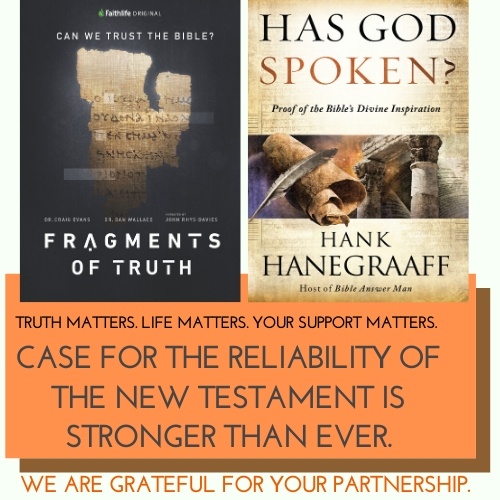Fragments of Truth DVD
From: $ 0.00
Dear Hank: With the reliability of the Bible under relentless attack and the faith of a younger generation at risk, Christians urgently need to know how to debunk these erroneous claims. Please use my gift to continue equipping believers to stand their ground by knowing how astonishingly reliable and accurate the New Testament is. (See further information in the “description” section below). Please send me:
Description
Description
A RESOURCE TO ENCOURAGE AND EQUIP YOU AS YOU STAND FOR LIFE AND TRUTH
Can we trust the Bible?
Our faith is based on the New Testament — but can we really trust the Bible? Skeptics say no, arguing that the Gospel manuscripts have been doctored to push a theological agenda.
Join Dr. Craig Evans as he takes this claim head on, traveling the globe to track down the most ancient New Testament manuscripts. Along the way, he highlights groundbreaking new evidence, demonstrating that the case for the reliability of the New Testament is stronger than ever. —From the cover, Fragments of Truth DVD (Faithlife Films). Narrated by John RhysDavies
Quotations and paraphrases from Fragments of Truth DVD
(Faithlife Films). Narrated by John RhysDavies.
Has Jesus been misquoted? How good are the manuscripts on which the New Testament is based?
Some have said that the text has been deliberately changed. We’ll look at the actual text that survived from antiquity, and talk to the experts who know best. Join us on our quest for the Fragments of Truth.
In 1897 two famous explorers, Bernard Grenfell and Arthur Hunt, traveled across Egypt in search of ancient manuscripts. Egypt’s dry conditions made the perfect place for manuscripts to be preserved in the sand for hundreds of years.
They wind up going to an Egyptian city about a 120 miles down from modern-day Alexandria, a place called Oxyrhynchus….And initially they didn’t find anything, till someone suggested the old trash heaps — mounds of sand — outside of the city limits. So they wandered out, in among these sandy mounds, to examine what was there. And one of them noticed a brown leaf sticking out of the sand, and he kicked it with his foot, and flipped over a page of ancient papyrus. And as luck would have it, it was from the Gospel of Matthew, chapter one, which today is P1, in our list of papyri. And so began then several seasons of digs, and over the years some 500,000 pages of papyrus text were recovered.
The average sized Greek New Testament manuscript is more than 450 pages long….So we have all together over 5,800 Greek New Testament manuscripts, more than 2.5 million pages of text. And our discoveries have not come to an end yet. There’s a good chance that we will continue to find copies of New Testament text in the near future.
Papyrus 45 confirms the soundness of the Greek New Testament
If you want to see biblical manuscripts but can visit only one place, Dublin, Ireland is the place to go. The Chester Beatty Library contains one of the most important collections of biblical manuscripts in the world, including the most ancient collection of all four Gospels, Papyrus 45, dated to about 200 to 250 AD….When the discovery of this manuscript was published in the Times, it was sensational, because it moved back the existing understanding of the Christian Text at least a 100 years closer to the time of the original writings. It really confirmed the soundness of the Text, as we understood it.
….What that tells us is that the earliest period was not nearly as free or chaotic as some scholars have supposed. What impresses me most, though, about P45 is that it dates to the very beginning of the third century. So, when that text was copied, some of the autographs (originals) of the Gospels could well have been still in circulation. P45 could be a witness, then, to the originals or at least the earliest copies of the Greek New Testament Gospels.
The burden has shifted
Could it be possible that when these papyri were written, the autographs, the originals, and early copies were still in circulation?….You know there were some early Church Fathers who thought so. Tertullian writing in about the year 190 — responding to heretics who had mutilated Paul’s letters, changing the wording — he said, ‘look, it reads this way, and you can see his letters,’ and he’s referring to the autographs, the originals, and he actually named the cities where they were located, six or seven of Paul’s letters, the originals still in existence at the end of the second century. The Church Father, Bishop Peter, says the same thing about the Gospel of John, the original is still at Ephesus where the faithful kiss it. So this means the burden of proof has shifted away from those who say the Text is stable; the burden now rests heavily on those who say we shouldn’t trust the Text, the Text has been changed, and therefore, we might never know what the Text originally showed.
We can be very confident that we have the original wording…
We can have a great deal of confidence that we have the original wording on the printed page of a Greek New Testament. It’s either in the text or it’s in the footnotes. We know what Paul said, we know what the rest of the writers in the New Testament wrote, because of this vast amount of great manuscript evidence we have from early on through the centuries.
Has God Spoken? Proof of the Bible’s Divine Inspiration
Through media, manuscripts and movies-and now most notably through the Internet-political pundits, professors and public personalities are raising doubts in the minds of millions regarding the notion that God has spoken and the Bible is a reliable repository of what he has said.
Has God Spoken? Proof of the Bible’s Divine Inspiration is the final book in a series – after origins and the resurrection – by Hanegraaff that covers the three major issues Christians must face in order to successfully defend the Christian worldview. Aiming to give a clear defense of the God-breathed inspiration of the Bible, Hanegraaff offers compelling, memorable proofs to show Scripture’s divine nature.
Using the acronym MAPS, Hanegraaff masterfully reveals that “the Bible, like a Rock of Gibraltar embedded in a sea of manuscript copies, is yet and forever will be an immovable bulwark fueling our faith and shattering the waves of skepticism and doubt.”
“Has God Spoken? is the culmination of my life goal to provide seekers, skeptics and saints alike with a memorable means by which to internalize answers to the three great apologetic issues of this or any other generation,” Hanegraaff says. “These answers are ultimately foundational to life and living and to living after life.”
Additional Info
Additional information
| March 2020 Resource | Fragments of Truth DVD, Has God Spoken book, Fragments of Truth DVD -AND- Has God Spoken book |
|---|




